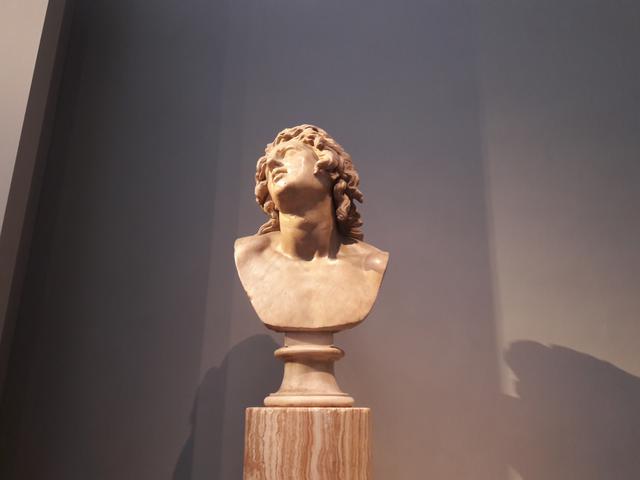Alexander dying

The bust with the lower half of the neck and the corresponding part of the tufts at the nape of the neck, the long tuft on the left side of the face, parts of other tufts, the front half of the nose are modern restoration. The hair on the top of the head appears to be reworked on the surface, while on the face the preservation of the old epidermis is excellent. Regarding the restoration of this head we have received news and testimonies; in fact, it is known that in 1579 Giambologna was entrusted with the "etiquette" and restored it; in 1586 the head was in the hands of G. Caccini for the restoration and execution of the bust; in 1784 there was a restoration by F. Carradori, which is certainly not the last, mentioned in 1795, when the bust was redone and the old bust returned from the Gallery to the Bureau of the Royal Factories. In the drawing by T. Angeletti, from the series executed for Francesco di Lorena, the bust presents armor and swamps and is also the porphyry copy of Poggio Imperiale, executed, apparently, in the second half of the century. XVI The other copy, certainly more recent, from the atrium of the ancient Orlandini palace in Florence (Monte dei Paschi), has a naked bust, but different from the current one; A swamp remnant on the side of the neck on the right bears a plaster cast (late 18th century?) in the Serena-Monghini Collection in Ravenna. The current restoration has successfully restored the shoulder slope.
U. Aldrovandi described a head similar to this, in his time in the house of Cardinal Pio de Carpi; Pelli identified the Carpi head with this one from the Galleria, which is very probable; in this case the "Alexander" belonged to Grand Duke Cosimo I after the death of Cardinal Pio (1564). Pelli adds that the existence of the porphyry replica is a document of the piece's ancient belonging to the Medici family. Certainly, the head was already a Medici property at the time of the restoration entrusted to Giambologna. It is in the Gallery of a very early date; in the sec. XVIII was in room VII, in XIX in the hermaphrodite room, now in corridor II.
If the Florentine head is one with that Carpi described by the Aldrovandi, even then it was recognized as a portrait of Alexander the Great, something quite obvious given the pathetic character of many portraits, even monetary ones, of that king; Later scholarship attempted to explain the moment in Alessandro's life to which the supposed portrait should have referred: after all, the Aldrovandi mentioned the moment when the dying king kissed his hand; Bianchi, taken by Pelli, reports the question of whether Alessandro was represented after the Battle of Cythno or the capture of Ossidraca, however Alessandro was wounded. For Amelung it was the discovery of the Pergamon sculptures to deny the commonly accepted identification, but it is perhaps no accident that EQ Visconti did not mention this head; Dütschke objected to the absence of pathetic expressions in the portrait. The comparison with the Alcyoneus of the group of Athena on the frieze of the great altar of Pergamum, first made by the Amelung, has made the new exegesis definitive as a dying giant; T. Schreiber instead considered Florence's head as a remnant of a group of fighters, something difficult for the character and for the hairstyle. Without contrasts the attribution to the art of parchment of the moment and the flavor in which the altar frieze was created; although the heads of the giants, and in particular of the Alcyoneus, reveal very different formal characteristics: a more intense drama supported by a more violent chiaroscuro, more decidedly serpentine strands and more densely crossed by lines of shadow, above all a more substantial structure of the volumes But these differences must refer both to the different function of the two works and to differences in temperament, even in the same climate. Lippold, who compares the marble of Florence with the airy works of Alcyoneus, points out that the pathos is stronger; Better to say that it is different, more spiritual, free of theatricality. The head certainly belonged to a statue, of which, however, it is impossible to indicate the type. Only Hamilton's replica of the head is known; this from Florence remains the most significant copy of a great lost Hellenistic original. The Madrid helmeted head should not be considered a copy; F. Cumont has reported some heads p.96, considered portraits of Alexander to the iconography of Mithras, because the cap, cut obliquely, suggests the presence of a separately worked piece; but this is not the case, contrary to what Cumont believed, of the head of Florence, which is complete. In any case, also for the Cumont the double thread of type A
© Tourblink